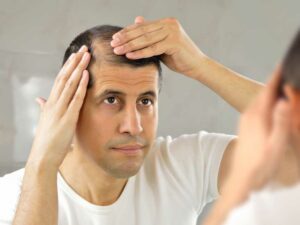 Regrowth recently caught up to Angela Christiano, the doctor who recently discovered the ‘hairless’ gene, which was touted as a potential future gene therapy treatment. This gene was originally mentioned for being responsible for alopecia universalis, but the term was meant as a general overall hairlessness, not the specific medical condition related to alopecia areata, so the gene is very far away from being directly linked to male pattern hair loss. It has definite potential to be used as a gene therapy for turning off the growth of unwanted hairs. Dr. Christiano hopes it will eventually help them find the link to other conditions like male pattern hair loss, but for now it is not known what will happen.
Regrowth recently caught up to Angela Christiano, the doctor who recently discovered the ‘hairless’ gene, which was touted as a potential future gene therapy treatment. This gene was originally mentioned for being responsible for alopecia universalis, but the term was meant as a general overall hairlessness, not the specific medical condition related to alopecia areata, so the gene is very far away from being directly linked to male pattern hair loss. It has definite potential to be used as a gene therapy for turning off the growth of unwanted hairs. Dr. Christiano hopes it will eventually help them find the link to other conditions like male pattern hair loss, but for now it is not known what will happen.
Regrowth: You must’ve been really busy with people calling about this.
Christiano: I have been. I’m still shocked by the whole thing. It’s a little overwhelming for a mere cave dweller scientist like me to be thrust out in the daylight like this. It’s a little much. I like your web site. I have to tell you I’ve been a fan for a long time.
Regrowth: Thanks… there’s been a lot of speculation about whether ‘hairless’ is a specific gene that can be useful in androgenetic alopecia. Do you think this gene is directly related or specific to alopecia [androgenetica]? If not directly then how do you see the discovery leading to a discovery for a gene?
Christiano: My hair fell out; I guess you know that right? Well that’s how it started… I’m 32 and when I turned 30 a few years back I was coming here to Columbia so I was sort of starting a full time job and finishing my training and moving to New York and at the same time going through a divorce and turning 30. So there was a lot of stress. Six months after that in the spring of 96 I was getting a haircut and the girl who cuts my hair saw these big bald spots in the back – three of them – and says, “Oh what did you do, have a biopsy?” And I said what you are talking about, of course not.” So the next day I asked one of my neighbors to look at it thinking it was some little thing and my neighbor looks at it and says “Oh my god!” So that sort of is where it began… I came to dermatology so recently that I really believed that everything about hair follicle regulation is known… so I started looking in the database and there’s nothing! Really nothing understood at all about genes that regulate hair and I sort of sat there staring at the machine and thinking that this can’t be true — this can’t be that the rest of the world is doing genetics and nobody’s doing it on hair. So rather than start our work with a big problem like androgenetic alopecia, or what I have, alopecia areata, we decided to take sort of a reductionist approach and go for a very, very simple form of inherited hair loss — where it was clearly recessively inherited so we could track how it segregated through the family as opposed to androgenetic or alopecia areata where it’s really not known how it goes through families. So for a genetics point of view we needed to find a large enough family with enough infected people to do the genetic linkage. So we started with this family in Pakistan for just that reason: because we could do the linkage and hopefully identify the gene. In contrast to the family we studied, the Pakistani family, which is a single gene defect, is that male pattern and probably alopecia areata are probably polygenic, meaning there’s more than one gene that does everything. Whether ‘hairless’ is among those we don’t know yet… hairless is clearly one of the early genes involved in hair regulation, because without it nothing downstream can be made, and so we like to fantasize about the hair cycle as a clock and that certain checkpoints on the clock must be passed through before a hair can be generated, and we believe ‘hairless’ is one of those first checkpoints — and because hair loss is a ‘switch’ gene — it’s a transcription factor — it’s job is to turn on other genes, we believe that whatever it turns on may also be more genes along that pathway are potentially more targets for male pattern and the more common form. So I like to think of this discovery as sort of the first foothold basically into the genes that control the process and hopefully will lead us to understanding the entire genetic basis of the process and therefore lead to therapy. I think the distinction I’d like to make is that the products that are available now, Minoxidil and Propecia, are very much treatments, because they work downstream… and we like to contrast that with if a therapy were aimed at the mechanics of the cycle itself then it might be much more permanent because it’d actually be working at the gene level where the problem starts and not some level far downstream. So I like to think of it sort of as a first step — first foot in the door into understanding the larger problems and then the confounding things like hormones and then immunity and problems like that…
Regrowth: Now discovering the gene is one thing and making something of it is another. Have you actually tried anything with this ‘hairless’ gene yet?
Christiano: Not yet. We have to do it in the mouse first, and of course we’re well under way with trying to put the gene back into the mice. One of the problems is that the mice and also our patients don’t actually have very good looking hair follicles left – so they’re kind of degenerated, so the liposome technology won’t work particularly well for this family because there’s not a hair shaft really to slide down. That would be in contrast to male pattern where there still are hair follicles — they’re just miniaturized. So for our families we’re trying a direct gene introduction at this point in the mice.
Regrowth: How long do you think it will take realistically for a gene treatment to be available to the public?
Christiano: When you talk to anybody in gene therapy whether it’s cystic fibrosis or anything else, everyone says five years. The reason for that is you really need just two things: the genes themselves and a way to deliver it to the target tissue. Once you have those two things in hand it’s just a matter of improving the context. Until now we didn’t have any genes at all to think about, and so I think that puts us within the five year framework because now at least some of the tools are in our hands.
Regrowth: Do you think it will work universally for all people?
Christiano: This is one of my big things with Propecia — it’s not being sold to women. But the beauty of a gene therapy should be that it would be universal. Everybody who has a certain defect should respond equally well. Then again because you’re working sort of at the hair follicle level itself you shouldn’t have to struggle against hormonal effects because you’re actually working at the gene level.
Regrowth: Do you think it would be applied only once or reapplied?
Christiano: Because each hair follicles cycles on its own clock, if you applied it only once you’d only hit a certain number of follicles at a given stage in the hair cycle. So my guess is that you’d have to apply it pretty regularly for a fixed time so each follicle was targeted and then probably after you had a good number targeted you might not need to use it.
Regrowth: What do you think will be the most likely long term result of your discovery — a treatment for alopecia areata or all genetic hair disorders?
Christiano: My biggest hope is that pharmaceutical interest will be generated to shift their interest from these downstream things to where I think a real treatment could make a difference. If it’s really good science then it will piss people off for a short time and then they’ll really start to think about it in a different way and it will benefit everyone if they will put some of their money and people behind it.
Christiano: The other side of the coin is for hair loss — once you learn how to control these genes, turning them off should be easier actually than turning them on.
Regrowth: How long do you think it will take to get something like that out?
Christiano: That depends a little on how friendly the gene is to us — how easy it would be for us to find either a peptide that inhibits it or someway of blocking its action. The other nice thing is that it’ll be topical… the whole question of side effects and systemic drugs should be eliminated, and that’s the beauty of any gene therapy — targeting the tissue you want and not the whole body.
Regrowth: What are your personal plans for future research?
Christiano: Obviously the turning off/turning on part is a big part of the story.
Regrowth: Have you done any of the animal testing yet or are you waiting to start that still?
Christiano: The animals have been ordered and the gene is ready. It took a few months actually to get the gene in the shape we wanted it in. So we’re ready to begin as soon as the mice get here.
Regrowth: How soon will it take to find out what the results are?
Christiano: I don’t actually know it’s kind of like you’re walking on the moon when you do this for the first time. We’ve got to get the gene in and make sure it’s turned on. That’s the first battle. There are markers to tell us whether it’s on or off. Once it’s on we sort of have to coerce the cells to try to make a new follicle almost because the follicles don’t really exist – so whether this gene could recapitulate that whole program – we don’t know what to expect. We’re hoping actually if we catch the mice young enough. When they have their first baby hair coat they still have follicles at that point. If we can catch them then, they still have follicles so we’re hoping to do the test as early as possible so we can preserve whatever follicles they have… This gene is going to be part of a pathway or a whole program of genes that makes hair and certainly understanding the genes that come next is a big part of what we do. Then starting in this program we’re hoping to start a large scale linkage study for male pattern, females, males and alopecia areata. That’s going to be a lot of work but it needs to be done and that’s the kind of future studies that should point the direction of two or three or four genes and give us a better idea of where they are and what they do. Those are kind of science fiction genetics at this point. No one’s ever used that approach successfully. People have tried it for schizophrenia and other psychiatric disorders where it’s been thought that there are many genes. Linkage has been shown but no one’s found the gene that’s been pointed from the linkage.
Regrowth: How is it you’re going to establish the linkage between the hairless gene and the other genes?
Christiano: We need to find out what targets the hairless gene binds to. It’s a DNA binding protein so part of it has to touch the next gene basically. So we have to – it’s like a fishing thing – you kind of bait your hook with the sequence you think hairless binds to and you sort of fish through a whole number of cell extracts and see what kinds of things stick to it. It’s so primitive but unfortunately that’s all that’s available right now.
Regrowth: What about other cosmetic uses such as changing hair color?
Christiano: There are a number of groups who work on pigments and they’ve already begun to experiment with ways to get them into the hair follicle and change color. They’re nice small genes so they’re easy to work with. People think that perhaps by introducing those into follicles you could restore color at the gene level.





